
Volume III ● Issue 2/2012 ● Pages 287–295
The Laboratory of Archaeobotany and Palaeoecology (LAPE)
at the Faculty of Science, University of South Bohemia (2002–2012)
University of South Bohemia, Faculty of Science – Department of Botany, Branišovská 31, 37005 České Budějovice, Czech Republic
http://lape.prf.jcu.cz/en/
Alex Bernardová, Jaromír Beneš, Lenka Kovačiková, Petra Houfková, Tereza Šálková, Veronika Komárková, Jan Novák, Jitka Kosňovská, Tomáš Bešta
1. Introduction
The Laboratory of Archaeobotany and Palaeoecology (LAPE) is a specialised unit of the University. It was established in August 2002 at the Faculty of Science, University of South Bohemia in České Budějovice (Budweis, Czech Republic). A significant advantage and benefit for the members of the new unit was, and still is, the presence of a large biological research centre, under the authority of the Academy of Sciences of the Czech Republic. It provides diverse experienced laboratories, departments and individual specialists. The founding idea of LAPE grew out of several years of previous research activity in the area of archaeobotany and palaeoecology, focused primarily on the topic of medieval Prague (Beneš et al. 2002) and several other sites. The predecessor research activity up until 2002 was associated with a group of, at that time, fresh researchers (P. Kočár, P. Pokorný, J. Kaštovský and others) under the informal leadership of J. Beneš. The first members of LAPE are still in frequent contact with our team, which is evident in publication and project activities (e.g. Beneš, Pokorný 2008). Despite a personnel shift, which is so typical of university life, a decade of work has shaped a compact team which operates in various scientific fields and research activities.
Our unit is currently part of the Department of Botany. Apart from the fact that LAPE is primarily specialised in archaeobotany, members of the unit also operate in the areas of archaeozoology, palaeoecology and environmental archaeology. As of 2006, the LAPE unit is closely connected with the Institute of Archaeology of the University through the topic of environmental archaeology. This joint interest connects both students of botany and students of archaeology and offers the interconnection of two diverse thought systems.
The essential purpose and aims of LAPE are:
The laboratory is under the leadership of Jaromír Beneš. It currently has more than 10 students in the bachelor‘s, master‘s and doctoral programmes, four professional researchers and several associated fellows and collaborators.
2. Current research activities
Our research is often conducted in cooperation with other institutions, the Institute of Archaeology, Institute of Geology and Institute of Botany of the Academy of Science, in order to acquire a multi-proxy approach, where the laboratory is responsible for the life science analyses. LAPE carries out archaeobotanical and archaeozoological analyses. These are primarily focused on macro-fossils, fresh wood and charcoals, pollen and diatoms. Apart from archaeozoology, we are able to provide analyses in palaeoentomology and archaeomalacology. Palaeoparazitological analysis in cooperation with the Institute of Parasitology (Bartošová et al. 2011) is newly evolving.
LAPE conduct research in a wide range of archaeological periods throughout the Czech Republic and Slovakia as well as several projects abroad as well, for example, in Egypt and in Svalbard.
2.1 Archaeobotany & Palaeoecology
Archaeobotanical research is primarily represented by analysis of pollen and maco-fossils, charcoals, fresh wood and diatoms. With these analyses, we are involved in various projects studying first and foremost lake sediments and other suitable sediments in order to reconstruct vegetation history, primary changes in vegetation and the amount of human impact. Currently, our projects involve analysis of sediments of fossil at Lake Komořany in North Bohemia, or reconstruction of the vegetation history in the Doksy region (Novák et al., 2012). Additional long-term projects are primarily archaeobotanically focused, with close cooperation with archaeological research e.g. in Prague, Chrudim or the vicinity of Olomouc (e.g. Beneš et al., 2002, 2012, Bartošová et al. 2011). Late Bronze Age sites in South Bohemia are systematically investigated in cooperation with the Institute of Archaeology, the Faculty of Philosophy and the Museum of South Bohemia in České Budějovice, where archaeobotany and archaeozoology represent a considerable part of the field activity and research efforts (Chvojka et al., 2009; 2011; Šálková 2010; 2011).
2.2 Dendrochronology & Dendroecology
The Dendro lab provides standard dendrochronological measurements and dating of wood samples from historical buildings or fossil finds. The team focuses on historic buildings in the Šumava Mountains, where the wood species structure and the changes in the used material for timber constructions have changed over time (Beneš et al. 2006). Another field of interest is building a standard chronology for Norway spruce in the Šumava mountains region and the impact of climate and site conditions (Čejková, Kolář 2009), or the dendroecology of alder and the dynamics of a wetland forest (Douda et al. 2009).
2.3 Archaeozoology
Our archaeozoological research, based on identification, analysis and interpretation of animal remains, is associated with several projects. We try to improve our understanding of the relationship between humans and the environment, primarily between them and the animal population on the basis of excavated animal bones and teeth studies in context with the location of our laboratory at the University of South Bohemia; regional archaeozoology is an important area of interest. Additional areas currently in focus include: the archaeozoology of the Prague New Town and Prague Old Town in the Middle Ages, the archaeozoology of the historic heart of medieval towns in the Czech Republic, analysis of bone tools, investigating animal burials in the Late Bronze Age, etc.
3. Research projects
3.1 Study of the former Komořany Lake
The former Lake Komořany represented the largest Holocene natural water body in the Czech Republic, situated in the basin of north-west Bohemia. The area of the lake was destroyed by brown coal mining activity. Several sediment profiles were gathered from the area of the water reservoir and stored in archives during the 1980s. Seven sediment cores were discovered and processed with a multi-proxy approach (grant number: GAČR 206/09/1564) over the years 2008–2012. The research aims at tracking changes in the lacustrine environment of the former lake within the Holocene using diatom, pollen, macrofossil, cladocera analysis and microcharcoals (Novák 2011).
3.2 Archaeozoology and palaeoecology of Neolithic Bohemia
The Archaeozoology of the Neolithic in Bohemia is the primary focus here with the aim of animal husbandry strategies reconstruction in the periods of the Linear Pottery Culture (LBK) and the Stroke Pottery Culture (SBK) based on osteological assemblages from significant settlements in the Czech Republic (Kovačiková 2009; Kovačiková, Daněček 2008; Kovačiková et al. 2012). One of the projects currently being worked on is “Neolithic Houses from Hrdlovka, NW Bohemia: Changing Shape and Changing Meaning” (grant number: GAČR P405/12/2173, Dir. J. Beneš). Palaeoecological research of the Neolithic period in the Czech Republic is of special interest to the laboratory members, in particular the interaction between Neolithic people and the environment (Beneš 2004).
3.3 An analysis of plant macro-remains from prehistoric sites in South Bohemia
As of 2005 we have systematically sampled prehistoric cultural sediments (settlement and funeral components) for plant macro-remains analysis. This research has been conducted in cooperation with the Department of Archaeology, Faculty of Philosophy, University of South Bohemia in České Budějovice, the Museum of South Bohemia in České Budějovice and Prácheň Museum in Písek (grant number GAČR – 404/07/1632 and GAČR – 404/09/P125). A number of the individual analyses have been published (list of papers in Šálková 2011). The aim of the research has been an interpretation of archaeological infills and layers and reconstruction palaeoeconomy of settlement areas (e.g. housing, economy, burials, ritual areas). Knowledge of crop macro-remains is necessary for the reconstruction of the subsistence strategy of prehistoric populations. Macro-remains of weeds could identify the character of prehistoric agriculture (planting, harvesting, processing and utilization of utility plants). The focus of the research is the the Late Bronze Age in the Bechyně region (Chvojka et al.2009; 2011; Chvojka, Šálková 2011; Šálková 2010).
3.4 An Early Medieval settlement site in Roztoky near Prague
In 2006 and 2008 archaeological excavations of a huge Early Medieval settlement (a site of the Prague type, frequently connected with the early Slavs) took place in Roztoky on the northern periphery of Prague, where more than 200 houses were discovered. LAPE ensured there the sampling and processing of archaeobotanical material and consequently the analysis of bones, teeth and charcoals. The uniqueness of the locality and the amount of samples led to an interdisciplinary project entitled “The puzzle of the Early Mediaeval settlement Roztoky. Patterns of land use, subsistence and the site formation” with the Institute of Archaeology of the Academy of Sciences of the Czech Republic, Prague, v. v. i. (grant number GAČR P405/10/2289, Dir. M. Kuna).
Archaeozoology has been participating in the clarification of the economic needs of communities which occupied the Roztoky settlement area. The majority of the osteological material which number thousands of animal bones and teeth were found in the features of the Prague-type culture. A smaller number of recovered bones was assigned to the sequential Early Medieval “Hillfort Period” (8–12th centuries). Anthracological research (Novák et al. 2012) was focused on the testing of the possible information value of charcoal analysis from an infill of archaeological features. A combination of three anthracological outcomes (the number of charcoal fragments, the anthracomass, and the qualitative frequency of charcoal species) has proven to be a powerful tool in determining the vegetation pattern in the surrounding landscape. The research revealed the major effect of postdepositional processes and quantification methods on the final anthracological interpretation.
3.5 Vladislav Hall at Prague Castle
The laboratory is involved in archaeological research at Prague Castle under the leadership of the Institute of Archaeology (Academy of Science, Dir. J. Frolík). The Prague Castle complex is one of the most important historical monument areas and archaeological sites in Czech history. It has been at the centre of the political life and the crossroad of economic activity since the Early Medieval period. The majority of the recent research was carried out in Vladislav Hall. Monumental architecture was built over the period 1492–1502 during the reign of Ladislaus II Jagiello and represents the largest vaulted area in all late Gothic architecture in Central Europe. Starting in the 16th century, Vladislav Hall served for royal state purposes, coronation festivities, banquets, knights‘ tournaments and markets with artistic and luxurious goods, amongst other things. During the wooden floor renovation the archaeological excavation revealed a waste vault infill. This completely dry and well preserved material provides a unique archaeological situation dating to the 16th and the 17th centuries. Numerous artefacts and items of daily use were found along with animal bones, timber and wooden waste, dishes, handwritings and prints. Imported fruit were represented in significant numbers including olives (Olea europaea), sweet almonds (Amygdalus communis), sweet chestnuts (Castanea sativa), pistachio nuts (Pistacia vera), nutmeg tree (Myristica fragrans), common box (Buxus sempervirens), citrus fruit, etc. Carob tree (Ceratonia siliqua) and coffee (Coffea arabica) were detected for the first time in Central Europe. Shells of peanuts (Arachis hypogaea) were found for the first time in all of Europe. All of these plants are unique and new in the context of archaeobotany in Central Europe (Beneš et al. 2012).
3.6 Palaeoecological research in the Domica cave, Slovakia
LAPE is involved in the research of a thousand year old guano deposit of bats found in the unique Domica Cave (southern Slovakia, Slovak Karst National Park, Beneš et al. 2009). It was re-discovered for scientific research and analysed palynologically and microbiologically. The task of LAPE is to coordinate the palaeoecological research and develop a strategy for the study of historical landscapes in cave surroundings, connected with proxy data from bat guano. Pollen data are used here to identify the preferred foraging habitats of the bats. The human impact on vegetation was recorded through cereals and cereal weeds. The cave seems to have been used both as spring and summer roosts. An analysis of pollen and the bats‘ diet preserved in the guano indicate that the bats did not depend on xerothermic flora exclusively but also exploited humid temperate forested habitats. The northern limit of the bat distribution range is therefore considered to have depended more likely on other conditions (probably the regional climate and/ or cave temperatures) than on vegetation (Svitavská, Svobodová et al., in press).
3.7 Egypt, palaeoecological research in the Abusir necropolis
Certain members of the LAPE unit were asked to take part in field research in a Czech expedition in Abusir, Egypt, which is held by the Czech Institute of Egyptology in 2004. The main task was to investigate the characteristics and mechanism of the Lake of Abusir, which was situated in the forefield of the Old Empire pyramid necropolis. This was carried out by the Czech Institute of Egyptology over recent years under the leadership of M. Bárta. These cemeteries were built to serve the capital of ancient Egypt, the White Walls, which was established around 3000 BC. The area under study was used as a principal entryway to the cemeteries of Saqqara and Abusir during the third millennium BC. All the results obtained by both field and laboratory research document the palaeoenvironmental and geoarchaeological history of the study area (Cílek et al. 2012). During the field research campaigns in Abusir, tasks for LAPE members (J. Beneš, J. Novák, A. Pokorná) were expanded into subsequent topics, connected with the investigation of archaeobotanical material from several mastabas and shaft tombs dated to the Old Empire period and the Late period. An analysis of archaeobotanical material from various archaeological structures ended in a series of particular chapter publications within a publication series devoted to Abusir issues (Novák 2010; Cílek et al. 2012; Beneš 2011a; 2011b)
3.8 Svalbard palaeoecological research
We collaborated on a project concerning biological and climatic diversity in the central part of the Svalbard archipelago where we cooperated on inter-disciplinary research of lake development and reconstructing past vegetation changes after the deglaciation of the area or the uplifting of terraces (Bernardová, Košnar 2012; Klimešová et al. 2012). The project is in cooperation with the Czech Geological Survey and the Institute of Botany, Academy of Science where members of LAPE provide environmental analyses, analyses of pollen and macro-fossils.
4. Educational activities
Students of the Faculty of Science have had the opportunity to obtain a Master degree in the specialization Archaeobotany or Archaeozoology. At LAPE, they undertake bachelor, master’s and doctoral theses in archaeobotany, which correspond with current field activity. The student‘s work in palaeoecology is concentrated on various aspects of landscape development, in particular the history of human impact on the palaeoenvironment. The main topics for student theses are reconstruction and understanding of past environments and economies in the Early and High Middle Ages in the Czech Republic via osteological or macrofossil analyses from city parcels (e.g. in Prague or Chrudim), castles and rural communities (e.g. along the medieval European salt trade route the ‚Golden path‘ in South Bohemia). When carrying out these student projects we cooperate with other institutions (e.g. the Museum of the Capital City of Prague, regional museums, etc.).
Members and collaborators of the LAPE unit organise several teaching courses at the Department of Botany and support a number of educational activities at the Institute of Archaeology. The main courses are: Development of Landscape in Central Europe (J. Beneš), Archaeobotany (J. Beneš, V. Komárková, M. Hajnalová), Archaeozoology (L. Kovačiková), Palynology (H. Svitavská-Svobodová) and Dendrochronology (A. Čejková, T. Kolář,). Joint diploma seminars for students of natural sciences at LAPE and for students of archaeology are extremely popular. These contact seminars support knowledge of archaeology among students of natural sciences, and additionally helps develop an improved understanding of archaeology among students of natural sciences. The above-mentioned courses are still fairly unusual for Czech universities. A new educational activity, thus far missing in Czech course offerings, consists of establishing the new course Historical Ethnobotany (J. Beneš, J. Kosňovská). The lectures are aimed at understanding the character and methods of historical ethnobotany within a world context. They are based on ethnological evidence of interaction between human and plants from prehistory up to the modern times. The seminars primarily consist most of specialised topics with a related practical workshop such as “the history of writing” and a related workshop where ink is made based on historical instruction or “the study of textile dying by plants” and making use of historical methods to create a collection of numerous herbal dyed textile.
4.1 Summer School in Netolice. Investigation of a cemetery with an ancient and recent DNA programme
As of 2007 a Summer Archaeological School has been organised every year for students of archaeology and natural sciences. The students work on site with finds of Early-Medieval Přemyslid hillfort castle, church and cemetery. The summer school provides an ideal way to introduce students to archaeobotanical sampling, storing and processing of material and how to work with results. LAPE is developing a long term programme concerning bioarchaeology and genetics of a medieval and early modern cemetery (11th –17th centuries). The primary task is to investigate the origin of people via ancient DNA in Netolice, South Bohemia in comparison with recent living inhabitation of the small town of Netolice and the near surroundings. The first results of both ancient and recent DNA taken by skeletons and living domestic humans in the area of Netolice are compared (E. Žďárský, V. Roubová, J. Beneš). Biological, cultural and language identity is discussed in connection with conventional archaeological and historical knowledge. In accordance with previous research, the local and extremely ancient origin of medieval and recent people is probable.
5. Services
The Laboratory of Archaeobotany and Palaeoecology works partly as a commercial lab conducting analyses in all major areas of archaeobotany, in particular the analysis of plant macro-fossils, pollen, diatoms, charcoal and wood. We also provide an analytical service in archaeozoology, malacology and an analysis of entomofauna and palaeoparasitology.
6. Databases and reference collection
The archaeobotanical reference collection of seeds, fruits, leaves and buds consists of more than 3000 items and is continually increasing. We also participated in the creation of the Czech Archaeobotanical Database (CZAD) and contributed with our data. Our laboratory contains a reference collection of a number of vertebrates, primarily mammals, birds and fish living in the Czech Republic. The collection is considerably extended by students from the Faculty of Science of South Bohemian University. This collection is not only used for analyses of animal skeletal remains from archaeozoological contexts but also during class work. A significant part consists of the collection of literature for determination of macro-remains, pollen or bones.
7. Selected recent publications
Bartošová, L., Ditrich, O., Beneš, J., Frolík, J., Musil, J. 2011: Paleoparasitological Findings in Medieval and early Modern archaeological deposits from Hradební street, Chrudim, Czech Republic, Interdisciplinaria Archaeologica – Natural Sciences in Archaeology II//1/2011, 27–38.
Beneš, J. 2004: Palaeoecology of the LBK: Earliest agriculturalist and landscape of Bohemia, Czech Republic, In: Lukes, A., Zvelebil, M. (Eds.): LBK Dialogues. Studies in the formation of the Linear Pottery Culture. BAR International Series 1304, 143–150.
Beneš, J. 2011a: Analysis of wooden finds from the burial shafts of AS 38, In: Vymazalová H. et al.: Abusir XXII. The tomb of Kaiemtjenenet (AS 38) and the surrounding structures (AS 57–60). Charles University in Prague, 168–171, 194–195.
Beneš, J. 2011b: Xylotomic analysis of wooden objects from the embalmer’s depozit of the shaft tomb of Menekhibnekau, In: Bareš, L., Smoláriková, K.: Abusir XXV, The Shaft Tomb of Menekhibnekau. Vol. I: Archaeology. Charles University in Prague, 182–184, 356.
Beneš, J., Čulíková, V., Kosňovská, J., Frolík, J., Matiášek, J. 2012: New plants at Prague Castle and Hradčany in the Early Modern Period: a History of selected species, Interdisciplinaria Archaeologica – Natural Sciences in Archaeology 3.1, 103–114.
Beneš, J., Kaštovský, J., Kočárová, R., Kočár, P., Kubečková, K., Pokorný, P., Starec, P. 2002: Archaeobotany of the Old Prague Town defence system, Czech Republic: archaeology, macro-remains, pollen, and diatoms, Vegetation History and Archaeobotany 11, 107–119.
Beneš J., Kolář T., Čejková A., 2006. Xylotomic and dendrochronological analyses in archeology: Changes in the composition type of wood in Prague an in Southern Bohemia, Ve službách archeologie VII, 159–169.
Beneš, J., Lillie, M. 2012: Marek Zvelebil and the Identity of Archaeology. Interdisciplinaria Archaeologica – Natural Sciences in Archaeology III/1/2012, 3–7.
Beneš, J., Svitavská-Svobodová, H., Novák, J., Křováková, K., Šantrůček, J., Elhottová, D., Kováč, L., Krištůfek, V. 2009: Reading the past from bat guanno. Domica cave palaeoecological research, Aragonit 14/2, 170–171.
Beneš, J., Žďárský, E. 2011: Mezi životem, smrtí a identitou. Archeologie a genetika o původu Jihočechů v Netolicích (Between life, death and identity. Archaeology and genetics about origin of people in Netolice, South Bohemia – in Czech), Dějiny a současnost 2011/7, 30–33.
Bernardová, A., Košnar, J. 2012: What do Holocene Sediments in Petuniabukta, Svalbard reveal? Polish Polar Research 33/4, 329–345.
BEŠTA, T., ŠAFRÁNKOVÁ, J., POUZAR, M., NOVÁK, J., NOVÁKOVÁ, K. 2009: Late Pleistocene – Early Holocene transition recorded in the sediments of a former shallow lake in the Czech Republic, Hydrobiologia 631, 107–120.
Čejková, A., Kolář, T. 2006: Analýza významných roků u smrku z oblasti Šumavy [Analysis of pointer years of Norway spruce from the Šumava Mountains]. In: Sborník referátů konference Historie a vývoj lesů v českých zemích 2006. ČZU FLE katedra pěstování lesů a správa NP a CHKO Šumava: 169–176 (in Czech).
Čejková, A., Kolář, T. 2009: Extreme radial growth reaction of Norway spruce along an altitudinal gradient in The Šumava Mountains, Geochronometria 33, 41–47.
Čejková, A., Poláková, S. 2012: Growth responses of sessile oak to climate and hydrological regime in the Zbytka nature reserve, the Czech Republic, Geochronometria 39/4, 285–294.
CHVOJKA, O., ŠÁLKOVÁ, T., BENEŠ, J., KOVAČIKOVÁ, L., NOVÁK, J. 2009: Březnice – první ploché pohřebiště mladší doby bronzové na Bechyňsku (Březnice – the first Late Bronze Age flat burial site in Bechyně region – in Czech), Archeologické výzkumy v jižních Čechách 22, 61–98.
Chvojka, O., Beneš, J., Fröhlich, J., John, J., Michálek, J., Šálková, T., Bernardová, A., Houfková, P., Křivánek, R., Majer, A., Novák, J., Nováková, K., Talarovičová, E. 2011: Osídlení doby bronzové v povodí říčky Smutné v jižních Čechách. [The settlement in the Smutná River basin during Bronz Age], Archeologické výzkumy v jižních Čechách. Supplementum 8. České Budějovice (in Czech).
CÍLEK, V., BÁRTA, M., LISÁ, L., POKORNÁ, A., JUŘIČKOVÁ, L., BRUNA, V., MAHMOUD, A. M. A., BAJER, A., NOVÁK, J., BENEŠ, J. 2012: Diachronic development of the Lake of Abusir during the third millennium BC, Cairo, Egypt, Quaternary International 266, 14–24.
Douda, J., Čejková, A., Douda, K., Kochánková, J. 2009: Development of alder carr after the abandonment of wet grasslands during the last 70 years, Annals of Forest Science 66, 1–13.
Klimešová, J., Prach, K., Bernardová, A. 2012: Using available information to assess the potential effects of climate change on vegetation in the High Arctic – North Billjefjorden, central Spitsbergen (Svalbard), Ambio 41/5, 435–445.
Kolář, T., Čejková, A. 2006: Dendrochronologická analýza dřevěných konstrukcí tvrze v zaniklé obci Býšov [Dendrochronological analyses of timber construction of the fort in abandoned village Býšov], Archeologické výzkumy v jižních Čechách 19, 219–223 (in Czech).
Kolář, T., Kyncl, T., Čejková, A. 2005: Využití jedlového dřeva v dřevěných konstrukcích historických staveb [Utilization of fir wood in historical timber constructions]. In: Sborník referátů konference Jedle bělokorá 2005 (European Silver fir – 2005), ČZU FLE katedra pěstování lesů a správa NP a CHKO Šumava: 207–211 (in Czech).
KOVAČIKOVÁ, L. 2009: Příspěvek k poznání výživy a hospodářského zázemí neolitického sídliště v Černém Volu, okr. Praha-západ, Archeologické rozhledy 61/2, 254–264.
KOVAČIKOVÁ, L., DANĚČEK, D. 2008: Užitkový význam hospodářských zvířat na neolitickém sídlišti v Holubicích. In: Beneš, J., Pokorný, P. (Eds.): Bioarcheologie v České republice. Jihočeská univerzita v Českých Budějovicích, Přírodovědecká fakulta and Archeologický ústav Akademie věd České republiky, Praha, v. v. i., 177–198.
Kovačiková, L., Bréhard, S., Šumberová, R., Balasse, M., Tresset, A. 2012: The new insights into the subsistence and early farming from Neolithic settlements in Central Europe: the archaeozoological evidence from the Czech Republic, Archaeofauna 21, 71–97.
Kovačiková, L., Novák, J., Prostředník, J. 2012: Emergency archaeological exploration of the Konejl´s cave in Klokočské rocks, Fontes Nissae XIII/2012/1, 57–67.
NOVÁK, J. 2009: Antrakologická analýza profilu MK IV v Krumlovském lese [Anthracological analysis of the MK IV profile in Krumlovsky forest]. In: Neruda, P., Nerudová, Z. (Eds.): Moravský Krumlov IV. Interdisciplinární analýzy, interpretace, důsledky. Anthropos, Brno. (in Czech).
NOVÁK, J. 2010: Xylotomical analysis of samples from the eastern group of mastabas. In: Bárta, M., Coppens, F., Vymazalová, H. (Eds.): Abusir XIX. Tomb of Hetepi (AS 20), Tombs AS 33–35, and AS 50–53, Charles University in Prague, Prague 356–358.
NOVÁK, J., PETR, L., TREML, V. 2010: Late-Holocene human-induced changes to the extent of alpine areas in the East Sudetes, Central Europe, The Holocene 20, 895–905.
NOVÁK, J., LISÁ, L., POKORNÝ, P., KUNA, M. 2012: Charcoal analyses as an environmental tool for the study of early medieval sunken houses infills in Roztoky near Prague, Czech republic, Journal of Archaeological Science 39, 808–817.
NOVÁK, J., SÁDLO, J., SVOBODOVÁ, H. 2012: Unusual vegetation stability in a lowland pine forest area (Doksy region, Czech Republic), The Holocene 22, 947–955.
NOVÁK, J., JANKOVSKÁ, V., BEŠTA, T., Dreslerová, D. 2011: Long term vegetation changes in the Bilina River region, Czech Republic, Saguntun 11, 139–140.
Pavelka, J., Kovačiková, L., Šmejda, L. 2011: The determination of domesticated animal species from a Neolithic sample using the ELISA test, Comptes Rendus Palevol 10/1, 61–70.
Řídký, J., Půlpán, M., Květina, P., Kovačiková, L., Stolz, D., Šreinová, B., Brejcha, R. 2012: Analysis and interpretation of finds from the Neolithic rondel ditch in Vchynice (Northern Bohemia), Archeologické rozhledy LXIV, 628–694.
Sádlo J., Pokorný P., Bernardová, A. 2010: Holocene history of Cladium mariscus L. in the Czech Republic. Implications to species population dynamics and palaeoecology. Acta Palaeobotanica 50/1, 65–76.
Šálková, T., Beneš, J., Komárková, V., Vaněček, Z. 2012: History of barley (Hordeum vulgare) in Central Europe according to archaeobotanical findings, Kvasný průmysl – Journal of Brewing and Malting 58/7–8, 215–227.
ŠÁLKOVÁ, T. 2010: Analýza rostlinných makrozbytků z objektů sídliště mladší doby bronzové v Březnici (Plant macro-remains analysis of the Late Bronze Age settlement in Březnice – in Czech). In: Popolnicové polia a doba halštatská. Bratislava, 308–316.
ŠÁLKOVÁ, T. 2011: Analýza rostlinných makrozbytků z pravěkých nalezišť jižních Čech.
(The analysis of plant macro-remains from prehistoric sites in South Bohemia – in Czech), Acta Fakulty filozofické Západočeské univerzity 4/2011, 205–214.
Sedláček, R., Beneš, J., Čejková, A., Kolář, T., Komárková, V, Kyncl, T., Novák, J., Nováková, K., Světlík, I. 2008: Studna z Dražkovic u Pardubic: komplexní archeologická a archeobotanická analýza [Wooden well from Dražkovice near Pardubice: complex archaeological and archaeobotanical analysis]. In: Beneš, J., Pokorný, P. (Eds.): Bioarcheologie v České Republice. Jihočeská univerzita v Českých Budějovicích, Archeologický ústav Akademie věd České republiky, České Budějovice – Praha (dendrochronological part: 299–305, in Czech).
Svitavská-Svobodová, H., Andreas, M., Krištůfek, V., Beneš, J. (in press): Guano, Pollen and Bats the Domica Cave and their Millennial History in the Slovak Karst National Park (Slovak Republic), Folia Geobotanica.

Figure 1. Palynologist Petra Houfková working with a microscope. Photo Aleš Motejl.
Figure 2. Prague Castle, Vladislav Hall during the floor reconstruction and archaeological excavation (above) with pictures of certain notable macro-remains (below). From left to right: pea nut (Arachis hypogaea), nutmeg (Myristica fragrans), carob tree (Ceratonia siliqua) and coffee (Coffea arabica). Marco-remains were found in the waste vault infill. Photo J. Kosňovská.
Figure 3. Domica cave, Slovakia. Jaromír Beneš, Jan Novák and Václav Krištůfek investigate a bat guano deposit in 2008. Photo Lubomír Kováč.
Figure 4. Abusir, Egypt. Jan Novák and Lenka Lisá takes samples from a trench at the former Abusir Lake in 2007. Photo J. Beneš.
Figure 5. Abusir, Egypt. Jaromír Beneš and Vladimír Brůna investigate a trench in the desert. Photo V. Cílek.
Figure 6. Svalbard. Alex Bernardová takes core at a shallow lake. Photo O. Strunecký.
Figure 7. Netolice. Jaromír Beneš searching for human bones during the Netolice summer school 2009. Photo A. Svatušková.
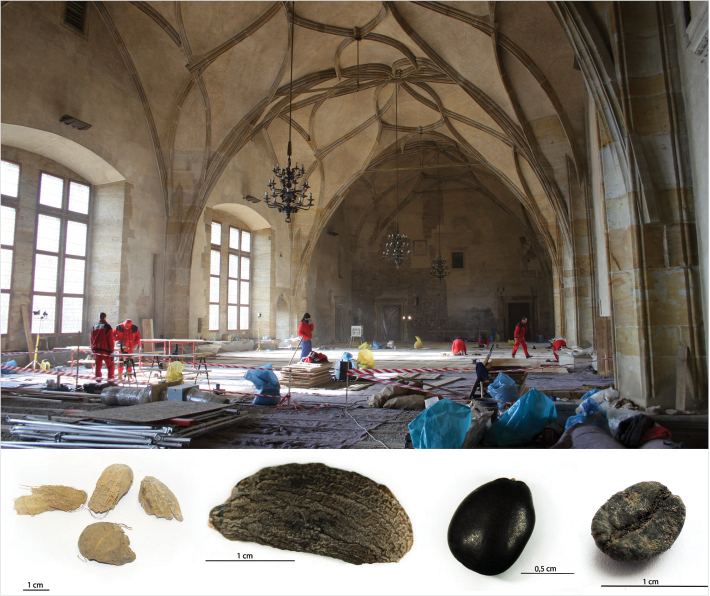
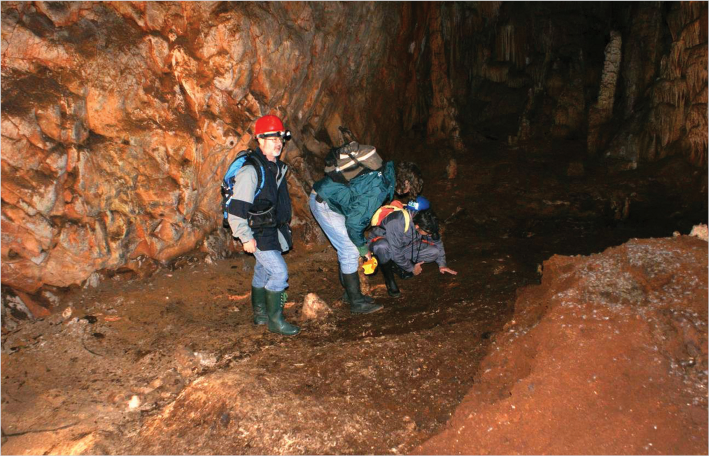
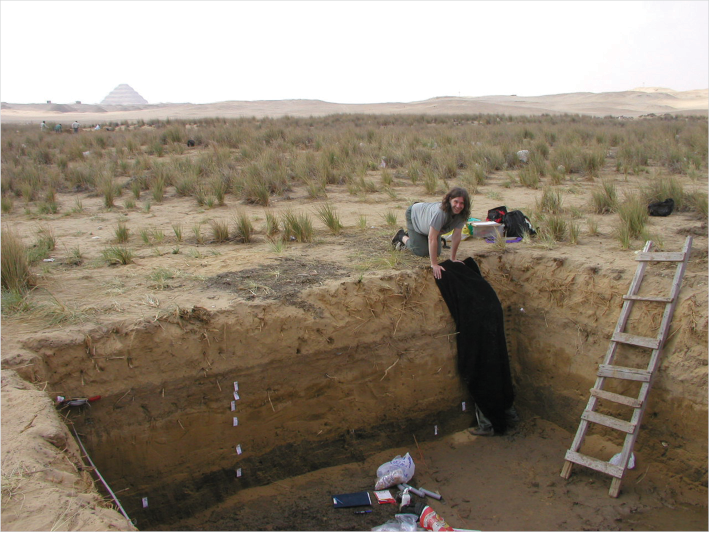

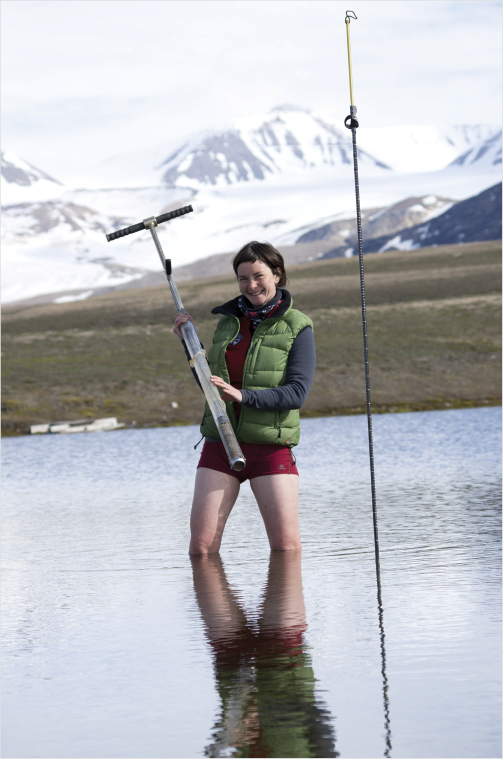
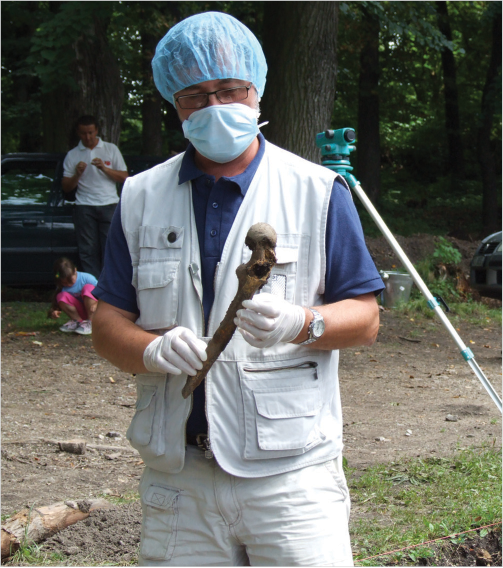
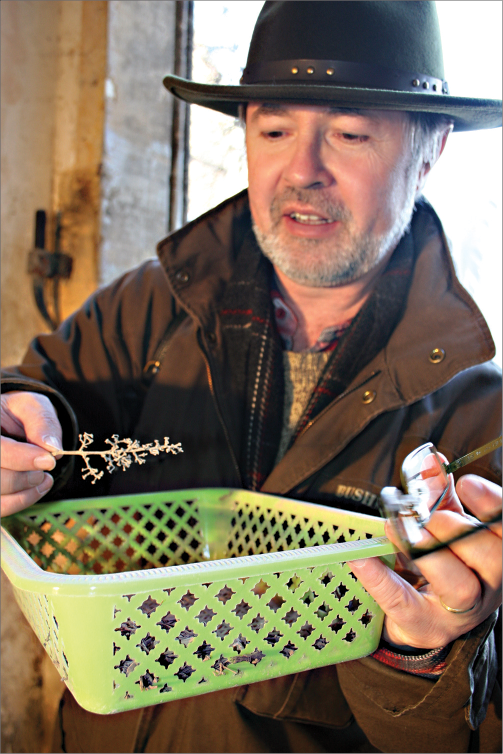
Jaromír Beneš – a scientific profile
Jaromír Beneš, PhDr., Ph.D. is an archaeologist and archaeobotanist, head of the Laboratory of Archaeobotany and Palaeoecology in České Budějovice. He studied archaeology at the Faculty of Philosophy, Charles University in Prague. He worked over the years 1983–1992 at the Institute of Archaeology, Academy of Science in Prague (Branch of rescue archaeology in the town of Most) where he focused on Neolithic and Bronze Age archaeology in North-West Bohemia and discovered, among others, the Early Neolithic (LBK, STK) site of Hrdlovka. He took part in the project Ancient Landscape Reconstruction in Northern Bohemia with the University of Sheffield and completed reconstruction models in the area of landscape archwaeology with a special interest focused on erosion and accumulative processes of the Czech landscape in prehistory and medieval times.
He works at the Faculty of Science, University of South Bohemia as of 1995 where he established the Laboratory of Archaeobotany and Palaeoecology in 2002. His specialisations are the study of deforestation processes in the Holocene, wood and charcoal analysis, field archaeology and the origins of agriculture. He has focused on landscape development in the area of the Bohemian Forest, specifically on the human impact on deforestation, as well as on archaeobotanical research of Neolithic and Medieval sites in Central Bohemia. He is a member of a project of the Czech Institute of Egyptology in a team working in Abusir, Egypt as of 2005.
Jaromír Beneš is head of the editorial board of the IANSA journal as of 2010. He is a lecturer in landscape archaeology, archaeobotany, historical ethnobotany and environmental archaeology. He is the leader of a bioarchaeological research project of the Early Medieval Přemyslid hillfort “Na Jánu” in Netolice where he organises a popular summer school in archaeology. He is also a musician (jazz guitar) and member of the university group ŠuKaS.
Selected publications (available at www.academia.edu):
BENEŠ, J. 1989: Reprezentativnost mobilní části archeologických kultur ve srovnání s etnografickými prameny – Representativity of the mobile components of archaeological cultures in comparison with ethnographic sources, Archeologické rozhledy 41, 629–649.
BENEŠ, J. 1991: Neolitické sídliště v Hrdlovce-Lipticích. Předběžná zpráva o výzkumu v letech 1987–1989, Archeologické rozhledy 43, 29–46.
BENEŠ, J. 1990: The small burial site from the Early Bronze Age in Jenišův Újezd: Comments on the deficient character of the population groups in the archaeological – anthropological picture, Anthropologie 28 (2-3), 137–147.
BENEŠ, J., BRŮNA, V. (Eds.) 1994: Archeologie a krajinná ekologie (Archaeology and landscape ecology). Most.
BENEŠ, J., ZVELEBIL, M. 1999: Historical interactive landscape in the heart of Europe: A case of Bohemia. In: Ucko, J., Layton, R. (Eds.): Archaeology and anthropology of landscape. Routledge, London – New York, 73–93.
BENEŠ, J., KAŠTOVSKÝ, J., KOČÁROVÁ, R., KOČÁR, P., KUBEČKOVÁ, K., POKORNÝ, P., STAREC, P. 2002: Archaeobotany of the Old Prague Town defence system, Czech Republic: archaeology, macro-remains, pollen, and diatoms, Vegetation History and Archaeobotany 11, 107–119.
BENEŠ, J. 2004: Palaeoecology of the LBK: Earliest agriculturalist and landscape of Bohemia, Czech Republic, In: Lukes, A., Zvelebil, M. (Eds.): LBK Dialogues. Studies in the formation of the Linear Pottery Culture. BAR International Series 1304, 143–150.
BENEŠ, J. 2008: Antrakologické analýzy v archeologii a paleoekologii – Anthracological analysis in archeology and palaeoecology, Archeologické rozhledy 60, 75–92.
BENEŠ, J., POKORNÝ, P. (Eds.) 2008: Bioarcheologie v České republice – Bioarchaeology in the Czech Republic. České Budějovice – Praha.
CÍLEK, V., BÁRTA, M., LISÁ, L., POKORNÁ, A., JUŘIČKOVÁ, L., BRŮNA, V., MAHMOUD, A. M. A., BAJER, A., NOVÁK, J., BENEŠ, J. 2012: Diachronic development of the Lake of Abusir during the third millennium BC, Cairo, Egypt, Quaternary International 266, 14–24.
BENEŠ, J., ČULÍKOVÁ, V., KOSŇOVSKÁ, J., FROLÍK, J., MATYÁŠEK, J. 2012: New plants at Prague Castle and Hradčany in the Early Modern Period: a History of selected species, Interdisciplinaria Archaeologica – Natural Sciences in Archaeology III/1/2012, 103–114.